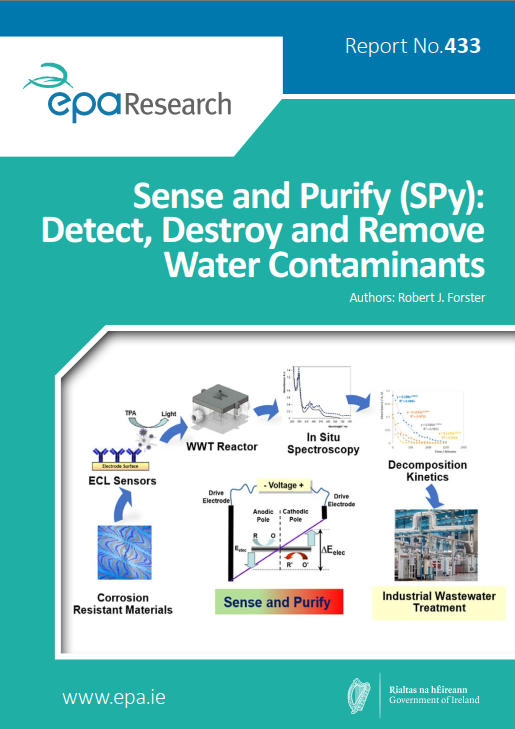Research 433: Sense and Purify (SPy): Detect, Destroy and Remove Water Contaminants
Authors: Robert J. Forster
Summary: Many wastewater streams, such as those from the pharmaceutical and food industries or from municipal wastewater, for example, contain pollutants. The SPy project developed the eco-innovative ‘Sense and Purify’ (SPy) technology, which has significant advantages over traditional treatment processes, including low operations costs, significantly lower energy consumption, higher conversion efficiency, better effluent water quality and lower waste production.

Project Highlights
Watch the project highlights video
This feature requires cookies. Open your cookie settings.
Identifying Pressures
Many wastewater streams, for example from the pharmaceutical and food industries or from municipal wastewater, contain pollutants. These include active pharmaceutical ingredients, herbicides, pesticides and, increasingly, personal care products, which cannot be efficiently removed or broken down with conventional primary, secondary (biological) and tertiary treatments. Moreover, the current practice of “pooling” wastewater from many different sources and treating centrally is not ideal, since the treatment method cannot easily be optimised to address the different pollutants present. There is growing recognition that powerful treatments are needed that can process diverse biological and synthetic organic compounds, and can be implemented at the point of production. Our work focused on advanced oxidation processes (AOPs) that can degrade and even mineralise recalcitrant organic matter from wastewater through reaction with hydroxyl radicals using sustainably generated electricity.
Informing Policy
The eco-innovative ‘Sense and Purify’ (Spy) technology, developed by the project, has significant advantages over traditional treatment processes, including low operations costs, significantly lower energy consumption, higher conversion efficiency, better effluent water quality and lower waste production.
From a policy perspective, SPy technology could make it easier to comply with environmental regulations and standards for wastewater treatment. It has proven effective at removing persistent pollutants, such as pharmaceuticals, personal care products and endocrine-disrupting compounds, which can be difficult to remove using conventional wastewater treatment processes. The use of AOPs can help wastewater treatment plants to comply with regulations and standards for discharge of treated wastewater into surface waters.
From a societal perspective, SPy’s findings can help to protect public health and the environment by removing contaminants from wastewater that could potentially harm human health or aquatic life. This can help to ensure that treated wastewater is safe for discharge into surface waters or for reuse in non-potable applications.
From a commercial perspective, the demand for wastewater treatment services is increasing significantly and the market for AOPs and other advanced treatment technologies is growing.
Developing Solutions
SPy technology allows organic molecules and pathogens to be decomposed and mineralised to carbon dioxide, ammonia and water, by generating a high concentration of a powerful oxidising agent, hydroxyl radicals, throughout a water sample with high electrical efficiency. The active agent has no persistent toxicity and can be implemented at source. It is also highly mobile/portable, low cost, compatible with flow-through reactor design, energy efficient and environmentally friendly. A laboratory-scale prototype reactor was developed that uses titanium feeder electrodes to generate an electric field that allows the voltage of boron-doped diamond (BDD) particles in suspension to be controlled. By controlling electrode separation, the voltage applied to the feeder electrodes and BDD particle size, the BDD particles suspended in the wastewater produce hydroxyl radicals that then decompose the organic pollutants. To monitor the decomposition of organics, UV-Vis spectroscopy was used. The absorbance correlates well with total organic carbon content. The system was tested for the treatment of pharmaceutical wastewater and is capable of mineralising non-steroidal anti-inflammatory and anti-cancer drugs within 1–5 hours.
https://www.epa.ie/media/epa-2020/research/research-publications/Report-Cover-Image-433.png